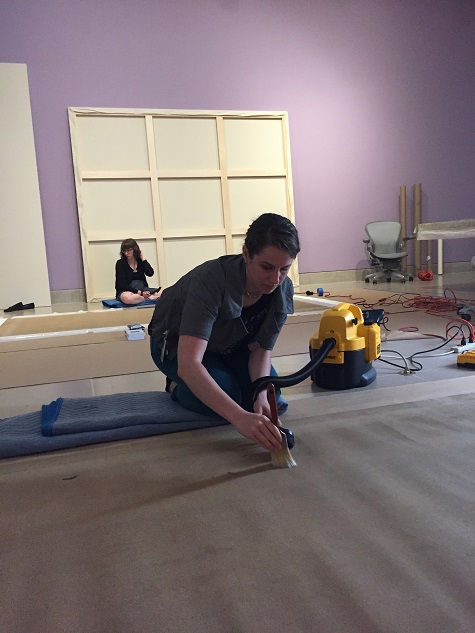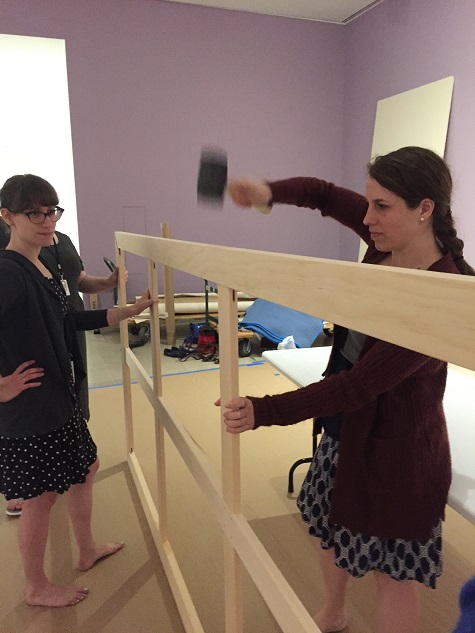If you have wandered past the Barrel Vault Quadrant Galleries during the initial stages of the Edward Steichen: In Exaltation of Flowers conservation project, you likely saw a lot of beige—new stretchers, plain cotton-duck fabric, and backsides of paintings—and five women hammering, measuring, and stapling away. A handful of visitors have asked us what we are doing or if we are the artists, so we thought we should explain a bit about the initial and necessary steps in the conservation of these magnificent murals. While the most glamorous parts of conservation treatments are usually the final steps like inpainting and varnishing, the beginning of a project often includes a lot of preparatory work and a healthy amount of elbow grease, and it is just as important that we are precise in these first stages of treatment as we are in the final steps.
The seven large paintings that make up Steichen’s In Exaltation of Flowers were commissioned by Agnes and Eugene Meyer for their townhouse in Manhattan. Due to financial difficulties, however, the murals were never hung in their intended environment (read more of the history here). The paintings were shown as a set only once, in 1915 at the Knoedler Gallery in New York City, and have not been shown in a series since. Records indicate that two or three of the paintings were shown individually in exhibitions between 1915 and the present, and one painting arrived at the DMA already stretched. Aside from this, the paintings were stored rolled before coming to the DMA, accumulating dirt and dust for over 100 years.

Keara Teeter using a soft brush and vacuum attachment to remove dirt and dust from the reverse of a painting.
In order to help remove a century’s worth of grime, we vacuumed the reverse sides of each unstretched painting. This process is likely not what you are picturing; we don’t take the Dyson out of the closet and roll it over the canvas, wheels and all. Instead, we use a soft-bristle brush to sweep particulates into a vacuum attachment nozzle, with the vacuum on a low setting. When the painting is unstretched and on the (clean, paper-covered) floor, as these are, vacuuming can involve a bit of body contortion and a lot of ab muscles to ensure the nozzle and brush reach all areas of the canvas while the motor of the vacuum and our knees do not.
Six out of the seven paintings came to the DMA unstretched, and with their original stretchers nowhere to be found. Shiny new stretcher bars were ordered from Simon Liu, Inc. in New York, and it took all of our project interns to assemble six of these massive supports for the paintings.
Once the stretchers were assembled, we created what is known as a loose lining. This involves attaching plain cotton-duck fabric to each stretcher, using canvas pliers and arm muscles to make sure each one is taut, and securing each one with staples. Later in the project, we will stretch Steichen’s paintings over these loose-lined stretchers, and the first layer of cotton-duck fabric will serve as a sort of bed for the paintings. Even though the canvases are in very good condition for being centenarians, they are somewhat weak where they have been folded over stretchers in the past, and the fibers have aged and become more brittle. The loose lining provides support and protection for the original canvas, and ensures that we do not have to pull hard on the original canvases to achieve planarity when they are stretched.
The next steps in our treatment will involve attaching edge linings to the original canvases, stretching the paintings over the loose linings, and performing some analysis with X-Ray Fluorescence in order to determine what elements are present. Stay tuned to learn more about these processes!
Pamela Johnson is a Conservation Intern at the DMA.
